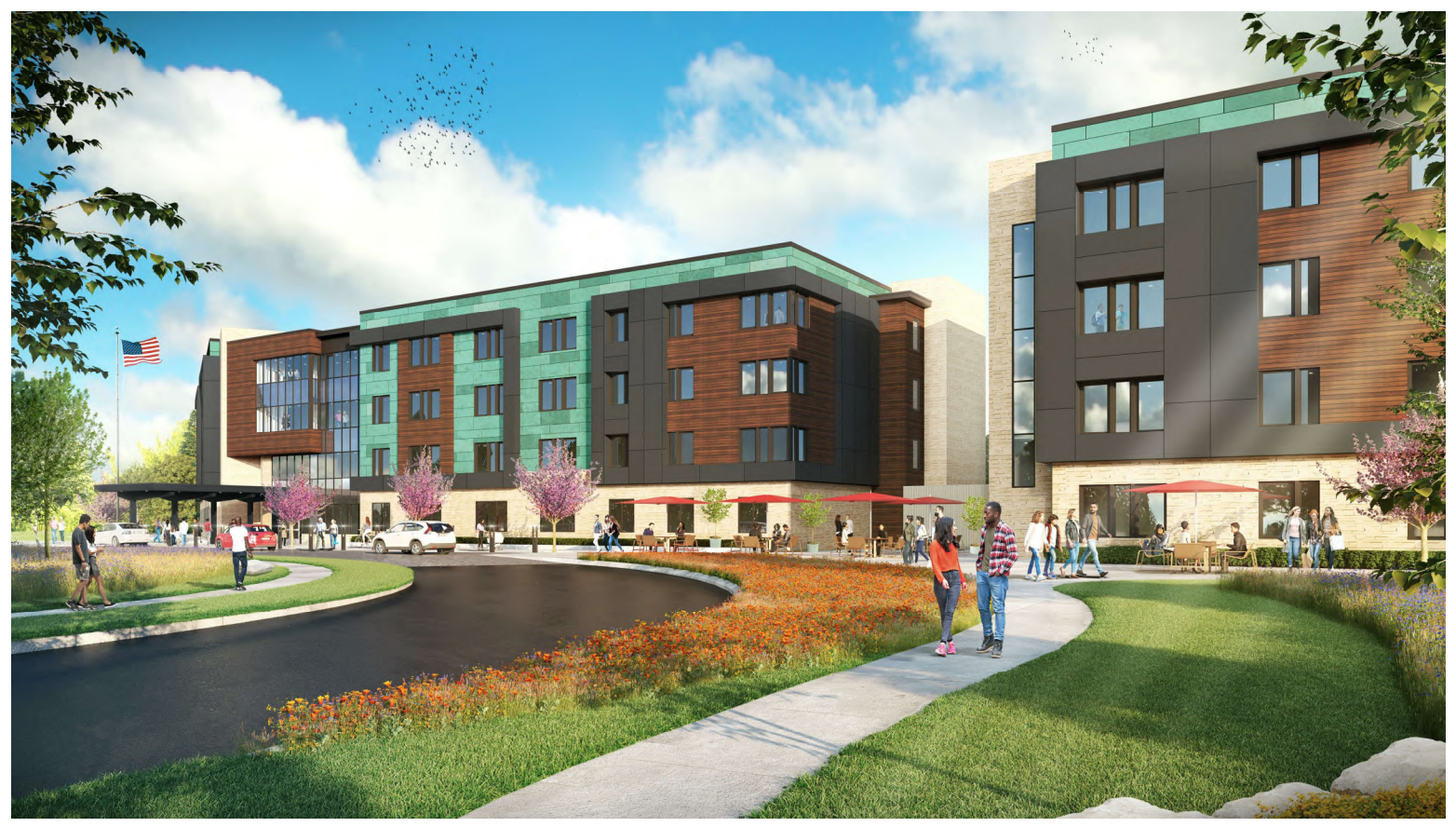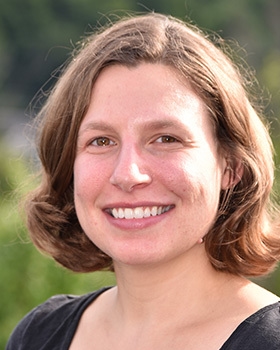Decarbonizing Multifamily Affordable Housing Developments in New York State

Pan American Square is a 150-unit new construction project in Buffalo, NY. HCR and NYSERDA CEI funds will be used to install heat-pump systems for space heating and cooling and a high performance envelope. Source: NYSERDA
The New York State Energy Research and Development Authority (NYSERDA) and New York State Homes and Community Renewal (HCR) partnered to accelerate the decarbonization of multifamily affordable housing developments in New York State. The Clean Energy Initiative (CEI) provides a replicable and scalable model to accelerate the decarbonization of affordable housing. The combined budgets and coordinated efforts of both organizations—and financing innovations—have allowed developers easier access to incentives and technical assistance to ensure tenants receive high quality living spaces that meet performance standards. This will allow more New York families to benefit from healthy, clean energy-powered homes, while providing housing developers with streamlined access to technical expertise and clean energy funding to support decarbonization efforts.
Meeting the Challenge to Achieve State Decarbonization Goals for Buildings
Under the 2019 Climate Leadership and Community Protection Act, New York State has mandated a 40 percent reduction in greenhouse gas emissions by 2030, and an 80 percent reduction by 2050. To achieve these goals, New York must significantly reduce emissions from its six million buildings. The state has also committed to achieve two million climate-friendly homes by 2030—specifically, one million electrified homes and one million electrification-ready homes—including at least 800,000 low- and moderate-income households. Given these mandates and commitments, the state is focusing resources on a new model to incentivize electrification and high-performance envelopes in affordable multifamily housing.
The CEI developed a model for decarbonizing HCR’s affordable housing portfolio, with technical and financial support in the amount of $100 million provided by NYSERDA. The CEI seeks to deliver building decarbonization incentives to HCR affordable housing projects within HCR’s established project intake and funding disbursement processes. This effort addresses the challenge of traditional state efficiency incentive programs that require extensive outreach, coordination, and application processes for developers, and that can result in the uncertainty —or asynchronous timing—of when incentive funding is committed and provided to project developers.
In traditional energy incentive programs, applications and subsequent incentive funding requests often entail rounds of document revisions and site visits by program management staff, which can add substantial soft costs and require significant investment up front. These processes can adversely impact project schedules as they are often separate from the timing and processes required by other agencies, regulatory bodies, and/or private lenders involved in a project. These overlapping processes, involving multiple agency programs, create a barrier for affordable housing developers to access building decarbonization incentives in an efficient and timely manner.
In addition to these hurdles, NYSERDA incentives are typically paid out upon project completion. Owners and developers must take on additional construction financing debt to support the project until incentives are disbursed, since the incentives cannot always be considered a source of financing at the time of closings for HCR construction finance agreements.
Regarding project performance criteria, HCR’s current Design Guidelines prescribe design standards that all developers must follow when applying for HCR financing, which helps the agency ensure that tenants receive high-quality living spaces and specifies size requirements, space materiality, and some standards for mechanical equipment. The Design Guidelines also require developers to implement efficiency improvements based on standards prescribed by Energy Star Multifamily, NYSERDA incentive programs, LEED, and/or Enterprise Green Communities—relying on those criteria as project performance standards.
Benefits of Streamlining Applications and Improved Financing
The CEI model provides developers access to clean energy incentives, affordable housing finance, and tax credits from a single source. Developers applying for either HCR’s 4 percent Bond or 9 percent Low Income Housing Tax Credit (LIHTC) programs are now able to apply for additional clean energy incentives provided by NYSERDA through their regular Housing Financing Application. HCR will directly administer building decarbonization funds to the projects, creating a streamlined process for developers, while also providing technical support through NYSERDA and its technical assistance contractors.
This one-stop-shop approach also enables developers to utilize these funds as a source in the project’s proposed underwriting, instead of as a rebate after construction, allowing it to be seen as a source of revenue at construction finance closing. Project developers can apply for CEI funding within established HCR application processes and receive incentives alongside HCR funding disbursements, so there are no additional administrative hurdles. This is game-changing in terms of creating up-front funding for projects striving to meet high performance and innovative solutions to meet climate goals.
To access the new CEI funds, development teams must comply with the HCR Sustainability Stretch Standards outlined in the CEI application. The new CEI scope requirements to design deep envelope improvements to meet high-performance, whole-building U-values, R-values, and infiltration standards and/or replacing existing heating systems with heat pumps. The result will be deeper decarbonization scopes that will set standards for future iterations of HCR’s Design Guidelines, and lead to improved comfort and indoor air quality of tenants’ homes by removing carbon emissions producing equipment, such as oil-fired boilers and gas stoves.
Advancing Electrification in New York for Environmental Justice and Disadvantaged Communities
NYSERDA and HCR are offering substantial incentives for affordable housing decarbonization—up to $25,000/dwelling unit, depending on project scopes—through the CEI model to support projects that seek to achieve electrification and/or advanced envelope improvements. NYSERDA is also funding technical assistance contractors who will provide project-level support for project developers to facilitate integrated design and help the teams integrate these systems in projects’ predesign, design, bidding, construction, and post-construction phases.
All projects utilizing CEI funds are HCR-regulated affordable housing, and the tenants are low- to moderate-income New Yorkers. Heat pumps provide improved tenant comfort, can improve indoor air quality by eliminating fossil-fuel burning appliances, and give users more control over heating and cooling of their homes.
Delivering these benefits to underserved, low-income populations furthers NYSERDA’s goals for serving disadvantaged communities and supports the Climate Act mandate, which dictates that at least 40 percent of the State’s clean energy program benefits be allocated towards disadvantaged communities.
A Replicable Model
The CEI model is adaptable to new sources of funding, such as utility incentives or potential additional federal funds for clean energy programs, and it provides a replicable approach for integrating building decarbonization technical assistance and funding into established housing agency financing processes.
Through close coordination and joint implementation between different incentive programs (e.g., state agencies, utilities, and municipalities) and affordable housing agencies, incentives can be made available to applicants much more efficiently. It is also important to leverage technical assistance contractors to both assist project developers with implementing heat pump and/or high-performance envelope scopes, and to support housing agency staff with managing such projects and developing the administrative tools and internal capacity for doing so.
In 2022, NYSERDA and HCR were awarded a State Leadership in Clean Energy Award for the Clean Energy Initiative by the Clean Energy States Alliance (CESA). According to an independent panel of judges, “The Clean Energy Initiative tackles a challenging sector with an innovative and de-siloed approach for technical assistance and funding. The positive equity impacts from the decarbonization of affordable housing can be long-term and transformative. NYSERDA’s long-term vision is excellent, and the partnership with the housing authority [NYS-HCR] will help remove barriers to clean energy expansion.” For a detailed case study on New York’s Clean Energy Initiative, and the five other winners of the 2022 State Leadership in Clean Energy Awards, see a new report released by CESA in September 2022. Representatives from NYSERDA will discuss the Clean Energy Initiative in a CESA webinar on October 26 – learn more.
Published On
October 24, 2022

